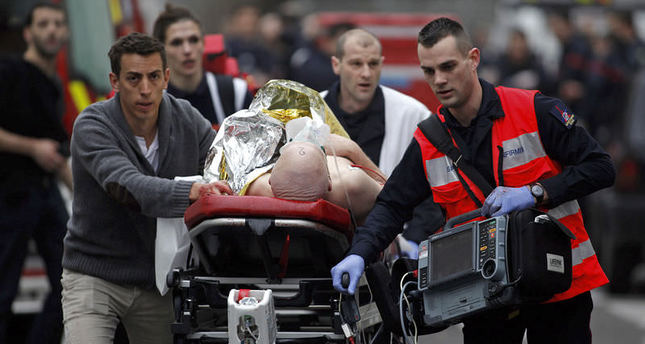Gunmen have shot dead 12 people at the Paris office of French satirical magazine Charlie Hebdo in an apparent militant Islamist attack.
Four of the magazine’s well-known cartoonists, including its editor, were among those killed, as well as two police officers.
A major police operation is under way to find three gunmen who fled by car.
President Francois Hollande said there was no doubt it had been a terrorist attack “of exceptional barbarity”.
It is believed to be the deadliest attack in France since 1961, when right-wingers who wanted to keep Algeria French bombed a train, killing 28 people.
The masked attackers opened fire with assault rifles in the office and exchanged shots with police in the street outside before escaping by car. They later abandoned the car in Rue de Meaux, northern Paris, where they hijacked a second car.
Death threats
Witnesses said they heard the gunmen shouting “We have avenged the Prophet Muhammad” and “God is Great” in Arabic (“Allahu Akbar”).
The number of attackers was initially reported to be two, but French Interior Minister Bernard Cazeneuve later said security services were hunting three “criminals”. He said that Paris had been placed on the highest alert.
Charlie Hebdo editor Stephane Charbonnier, 47, had received death threats in the past and was living under police protection.
French media have named the three other cartoonists killed in the attack as Cabu, Tignous and Wolinski, as well as Charlie Hebdo contributor and French economist Bernard Maris.
The attack took place during the magazine’s daily editorial meeting.
At least four people were critically wounded in the attack.
People had been “murdered in a cowardly manner”, President Hollande told reporters at the scene. “We are threatened because we are a country of liberty,” he added, appealing for national unity.
French government officials are holding an emergency meeting, and President Hollande is due to give a televised address later.
The satirical weekly has courted controversy in the past with its irreverent take on news and current affairs. It was firebombed in November 2011 a day after it carried a caricature of the Prophet Muhammad.
Global condemnation
The latest tweet on Charlie Hebdo’s account was a cartoon of the Islamic State militant group leader, Abu Bakr al-Baghdadi.
Charlie Hebdo’s website, which went offline during the attack, is showing the single image of “Je suis Charlie” (“I am Charlie) on a black banner, referring to a hashtag that is trending on Twitter in solidarity with the victims.
US President Barack Obama has condemned the “horrific shooting”, offering to provide any assistance needed “to help bring these terrorists to justice”.
UN Secretary General Ban Ki-moon said: “It was a horrendous, unjustifiable and cold-blooded crime. It was also a direct assault on a cornerstone of democracy, on the media and on freedom of expression.”
UK Prime Minister David Cameron said in a tweet: “The murders in Paris are sickening. We stand with the French people in the fight against terror and defending the freedom of the press.”
The Arab League and Al-Azhar mosque, Egypt’s top Islamic institution, have also condemned the attack.
Analysis: Hugh Schofield, BBC News, Paris
Charlie Hebdo is part of a venerable tradition in French journalism going back to the scandal sheets that denounced Marie-Antoinette in the run-up to the French Revolution.
The tradition combines left-wing radicalism with a provocative scurrility that often borders on the obscene. Its decision to mock the Prophet Muhammad in 2011 was entirely consistent with its historic raison d’etre.
The paper has never sold in enormous numbers – and for 10 years from 1981, it ceased publication for lack of resources.
But with its garish front-page cartoons and incendiary headlines, it is an unmissable staple of newspaper kiosks and railway station booksellers.








